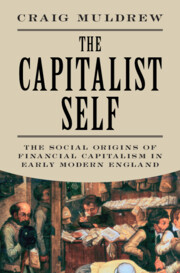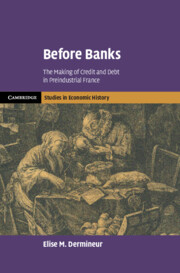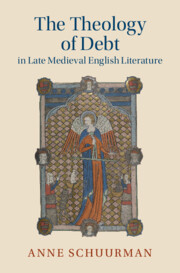Refine search
Actions for selected content:
103 results
2 - Value in Motion: The Inheritance of Merchant Capital and Debates over Credit
-
- Book:
- The Capitalist Self
- Published online:
- 12 October 2025
- Print publication:
- 30 October 2025, pp 57-100
-
- Chapter
- Export citation

The Capitalist Self
- The Social Origins of Financial Capitalism in Early Modern England
-
- Published online:
- 12 October 2025
- Print publication:
- 30 October 2025
8 - Commerce and Money Management
-
- Book:
- The Experience of Work in Early Modern England
- Published online:
- 19 September 2025
- Print publication:
- 09 October 2025, pp 285-314
-
- Chapter
-
- You have access
- Open access
- HTML
- Export citation
7 - Money, Credit and Banking
-
- Book:
- An Economic History of Europe
- Published online:
- 02 October 2025
- Print publication:
- 02 October 2025, pp 155-177
-
- Chapter
- Export citation
The Ottoman Sarraf, Public Debt, and Usury Laws: Rethinking Capitalism and Empire beyond Anomalies
-
- Journal:
- Comparative Studies in Society and History / Volume 67 / Issue 4 / October 2025
- Published online by Cambridge University Press:
- 14 July 2025, pp. 916-942
-
- Article
-
- You have access
- Open access
- HTML
- Export citation

Before Banks
- The Making of Credit and Debt in Preindustrial France
-
- Published online:
- 27 June 2025
- Print publication:
- 23 January 2025
6 - Banks as Creators and Stores of Money
-
- Book:
- Money In Crisis
- Published online:
- 15 July 2025
- Print publication:
- 12 June 2025, pp 133-157
-
- Chapter
- Export citation
Strangely inspired: Recovering a neo-Strangean approach to power, authority and knowledge for IPE
-
- Journal:
- Review of International Studies , First View
- Published online by Cambridge University Press:
- 11 April 2025, pp. 1-15
-
- Article
-
- You have access
- Open access
- HTML
- Export citation
3 - Price Personalization versus Contract Terms Personalization
- from Part I - Understanding the Phenomenon
-
-
- Book:
- The Cambridge Handbook of Algorithmic Price Personalization and the Law
- Published online:
- 20 March 2025
- Print publication:
- 27 March 2025, pp 65-87
-
- Chapter
- Export citation
Credit Data, Banks, “Packaging Agencies” and the Promise of Digital Lending to Small Businesses in China
-
- Journal:
- The China Quarterly / Volume 262 / June 2025
- Published online by Cambridge University Press:
- 13 February 2025, pp. 413-428
- Print publication:
- June 2025
-
- Article
- Export citation
State servants, cash, and credit market modernizations in early modern Stockholm
-
- Journal:
- Social Science History / Volume 49 / Issue 1 / Spring 2025
- Published online by Cambridge University Press:
- 24 October 2024, pp. 52-74
- Print publication:
- Spring 2025
-
- Article
-
- You have access
- Open access
- HTML
- Export citation
Costly enforcement in credit economies
-
- Journal:
- Macroeconomic Dynamics / Volume 29 / 2025
- Published online by Cambridge University Press:
- 26 September 2024, e37
-
- Article
- Export citation
11 - The Little Fellow and the Great Depression
-
- Book:
- Citizen Cowboy
- Published online:
- 16 August 2024
- Print publication:
- 29 August 2024, pp 284-316
-
- Chapter
- Export citation
5 - Money, Credit and Banking, 1000–1500
- from Section II - The Medieval Economy, 1000–1500
-
-
- Book:
- An Economic History of the Iberian Peninsula, 700–2000
- Published online:
- 22 February 2024
- Print publication:
- 29 February 2024, pp 130-157
-
- Chapter
- Export citation
Chapter 6 - Credit and Credulity
-
- Book:
- Mary Wollstonecraft and Political Economy
- Published online:
- 15 February 2024
- Print publication:
- 22 February 2024, pp 185-214
-
- Chapter
-
- You have access
- Open access
- HTML
- Export citation
4 - The Merchant House
- from Part II - The Lineaments of Racial Capitalism
-
- Book:
- Lucky Valley
- Published online:
- 11 January 2024
- Print publication:
- 22 February 2024, pp 156-201
-
- Chapter
- Export citation
Chapter 2 - Secret Debts
-
- Book:
- The Theology of Debt in Late Medieval English Literature
- Published online:
- 04 January 2024
- Print publication:
- 18 January 2024, pp 50-81
-
- Chapter
- Export citation
Discourse ethics for debt markets
-
- Journal:
- Finance and Society / Volume 2 / Issue 1 / 2016
- Published online by Cambridge University Press:
- 05 January 2024, pp. 62-85
-
- Article
-
- You have access
- Open access
- Export citation

The Theology of Debt in Late Medieval English Literature
-
- Published online:
- 04 January 2024
- Print publication:
- 18 January 2024
Hard cash, easy credit, fictitious capital: Critical reflections on money as a fetishised social relation
-
- Journal:
- Finance and Society / Volume 1 / Issue 1 / 2015
- Published online by Cambridge University Press:
- 09 November 2023, pp. 20-37
-
- Article
-
- You have access
- Open access
- Export citation
